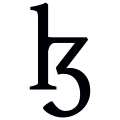Voiced alveolar lateral fricative
consonantal sound From Wikipedia, the free encyclopedia
Remove ads
The voiced alveolar lateral fricative is a type of consonant. Some spoken languages use it. The letter for this sound in the International Phonetic Alphabet is ⟨ɮ⟩ (sometimes called lezh). The X-SAMPA symbol for this sound is K\. The voiced alveolar lateral fricative is not used in English.
Remove ads
Features
- The airstream mechanism is pulmonic. This means that this sound is produced by pushing air solely with the lungs and diaphragm, as in most sounds.
- The phonation is voiced. This means that the vocal cords vibrate while the sound is being pronounced.
- The place of articulation (where the sound is produced) is alveolar. This means that this sound is produced with the tip of the tongue (apical) or the blade of the tongue at the alveolar ridge (laminal).
- It is a lateral consonant. This means that this sound is produced by directing the airstream over the sides of the tongue, but not down the middle.
- The manner of articulation (how the sound is produced) is fricative. This means that this sound is produced by constricting air flow through a narrow channel at the place of articulation, to make turbulence.
Remove ads
Examples
Dental or denti-alveolar
Alveolar
A pharyngealized voiced alveolar lateral fricative ![]() [ɮˤ] (help·info) is reconstructed to be the ancient Classical Arabic pronunciation of the Arabic letter Ḍād. (This means that linguists do not know how the letter was actually pronounced. However, by looking at modern languages, they think that this is how it was pronounced in the ancient language.) Today, the letter is pronounced in Modern Standard Arabic as a pharyngealized voiced coronal stop. This sound can be either alveolar [dˤ] or denti-alveolar [d̪ˤ].
[ɮˤ] (help·info) is reconstructed to be the ancient Classical Arabic pronunciation of the Arabic letter Ḍād. (This means that linguists do not know how the letter was actually pronounced. However, by looking at modern languages, they think that this is how it was pronounced in the ancient language.) Today, the letter is pronounced in Modern Standard Arabic as a pharyngealized voiced coronal stop. This sound can be either alveolar [dˤ] or denti-alveolar [d̪ˤ].
Remove ads
Notation

In 1938, a letter shaped similarly to heng ⟨ꜧ⟩ was approved as the official IPA letter for this sound. It replaced ⟨ɮ⟩. However, the International Phonetic Association also suggested that a compromise between the two letters could be used if the author wanted. This compromise letter was included in the 1949 Principles of the International Phonetic Association and the IPA charts of that year. Although the International Phonetic Association said to use this letter, some authors still used ⟨ɮ⟩ from the 1960s to the 1980s.[4][5][6][7][8] Later, this new letter was replaced by ⟨ɮ⟩ at the 1989 Kiel Convention.[9]
Related pages
Notes
References
Wikiwand - on
Seamless Wikipedia browsing. On steroids.
Remove ads
